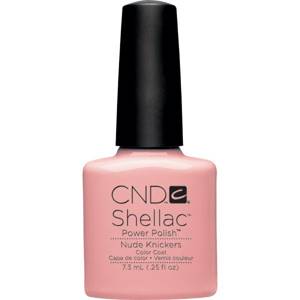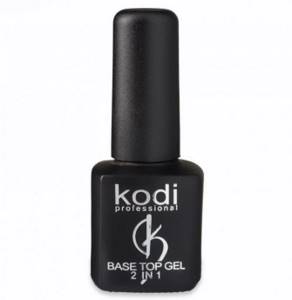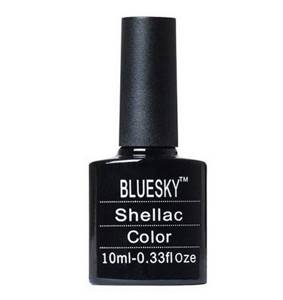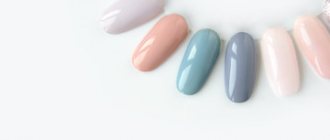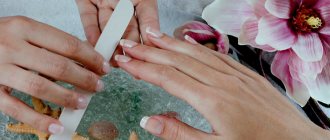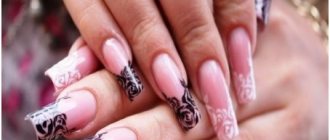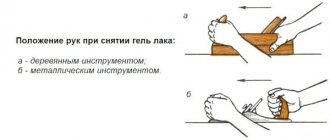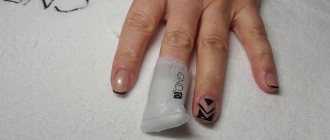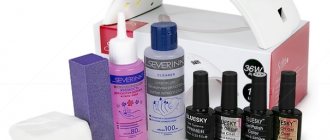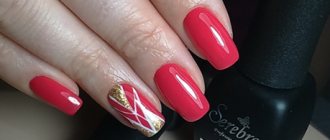Gel polish and shellac are the names of the same manicure procedures, but they differ in many characteristics: the cost of the procedure, the composition of materials, the duration of wearing the decorative coating, a variety of color shades, and the algorithm for applying the material.
It is important that gel polish and shellac are worn for an average of 2-3 weeks, thin the nail plate, and require careful care after application. The composition of gel polish is more harmful because it contains toxic components.
What is the difference between gel polish and shellac, are they the same thing or not?
Gel polish and shellac are not the same thing, although these materials have many of the same characteristics. To understand the essence of each material, it is enough to know the following nuances:
- For the first time, durable varnishes were created by CND. They received the common name Shellac.
- Other manufacturers created varnishes with similar effects that were resistant to abrasion/washing out for up to 14 days. They began to be called gel polishes.
- These two materials cannot be called similar, because they have significant differences.
| Gel polish | Shellac |
| Before application, you need to do a manicure and remove the top layer of the nail, apply a primer (base), colored varnish to the plate, and use a fixative (top). | The nail is not filed (this preserves the integrity of the plate), a primer for the decorative coating is not required, the fixative is applied as desired. |
| The color palette of gel polishes is very large (up to 90 shades for some manufacturers), you can use various effects such as “cat’s eye”, glitter, mother-of-pearl. | The choice of colors is limited to 30-50 shades; many decorative techniques for decorating nails are not available. |
Shellac can cause significant damage to the nail plate - in most cases, the nail becomes too dry and thin, and becomes more brittle. But this can be avoided if you contact specialists to apply the material and strictly follow their recommendations for the care and wearing of decorative coating.
By the way, in different sources there are different spellings of the name of the material for sustainable manicure - shilak, shellac, sherlac, schelak. But it is actually correct to write strictly according to the transcription of the original word - shellac.
Pioneer in the nail industry
Almost five years ago, the American corporation Creative Nail Design, better known as CND, introduced the world to a gel polish called Shellac. In Russia, the name was distorted beyond recognition, implying shellac, you can stumble upon shellac, shillac, shilak or shilak.
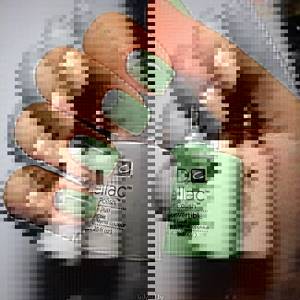
Shellac is a durable coating that is unique in its kind. If you dig a little deeper, this is the only gel polish in the world. Yes, it’s a gel polish, not a gel polish. The order of the words in the name emphasizes the percentage of content, so shellac has a varnish component to a greater extent than other gel polishes. It is also easy to apply, just like regular nail polish. Thanks to the gel included in its composition, its reliability and long-lasting results are ensured, which lasts up to two weeks.
Adherents of using shellac confirm that the gel polish really fulfills its stated requirements. The coating remains shiny and intact for the entire promised period of time.
Benefits of shellac:
- Apply like a varnish using a brush. Cures using an ultraviolet lamp. All corrections are possible before polymerization.
- Strengthens nail plates, making them stronger and healthier. Shellac is not only beautiful, but also useful. Hard nails become soft and flexible, while weak nails become hard.
- Unlike modeling, shellac does not add heaviness to the nails.
- Color constancy. Doesn't crack, peel off, don't fade, etc.
- Does not leave streaks or smudges. Nails are perfectly smooth and even.
- It will take you no more than half an hour to bring your marigolds to your cherished dream.
- The durability of the coating makes it attractive for both manicure and pedicure.
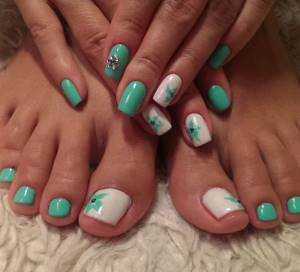
Gel polish and shellac - what's the difference?
The difference between gel polish and shellac is their composition and cost.
| Characteristic | Gel polish | Shellac |
| Base material | gel | varnish |
| Harmful substances in the composition | formaldehyde, toluene | completely absent |
| Choice of colors | the range includes about 30 shades, some manufacturers have increased this number to 90 | 60 shades |
| Acetone included | must be present | not contained |
| The need to use a primer | definitely needed | not used |
| Removing the coating | performed only by a master | can be done independently at home |
| Time of “hardening”, polymerization of the material | 2-3 minutes in UV light, 30-60 seconds in LED equipment | much faster than gel polish |
| Probability of correction | can be done at any time | coating restoration is not provided |
By composition
If we consider the composition of materials for manicure, then gel polish contains highly toxic substances such as formaldehyde, dibutyl phthalate - they inevitably cause allergic reactions, the body will be constantly poisoned by toxins. Shellac also contains not the most beneficial components (methacrylates, titanium dioxide), but they do not have a pronounced detrimental effect on the functioning of organs and systems.
By polymerization
The polymerization process also differs for the materials in question - for example, to harden shellac, only UV lamps are needed; other light rays simply will not act as they should on the decorative coating.
But gel polish polymerizes perfectly under LED devices, and from a practical point of view, this is much more convenient for both the artist and the client.

Gel polish is considered a more durable coating, especially if it is applied in 2-3 thin layers and each is dried separately in a special lamp - the beauty lasts for at least 15 days, sometimes up to 20-30 days. Shellac, on the other hand, allows hands to remain attractive for a maximum of 15 days, although such a coating can peel off before the specified period if the rules for caring for it are not followed.
Differences in coating removal
Removing the coating from the nail plate for both gel polish and shellac should only be done by a specialist, because peeling off on your own leads to damage to the plate and long-term recovery. This process is quite labor-intensive, which can be carried out at home, but only with mandatory adherence to the manipulation algorithm:
- Using a nail file or a ceramic corn cutter, cut off as much of the decorative coating as possible.
- Soak cotton pads in regular nail polish remover. Wrap your nails with them and put foil on top in the form of caps. Such a “compress” will eliminate the possibility of the nail polish remover evaporating before it dissolves the decorative coating.
- Wait at least 15 minutes, it is better to increase this period to 30 minutes.
- Remove the cotton pads with foil.

The same algorithm should be followed when removing shellac, but with one difference - you do not need to file it before using nail polish remover. But you need to take into account that in this case, after removing the cotton pads, there may be remnants of the coloring pigment on the nail plate. They are removed with an orange stick from a standard manicure set.
But if professional means are used to remove the coating, and the manipulation is carried out by a master, then undesirable consequences can be avoided.
How is gel polish different from regular polish?
Gel polish differs from regular polish in that:
- The latter is a decorative coating that gives the nails a certain color and sometimes texture, shine or matte.
- Conventional varnish is not durable, low cost and easy to use.
- Sometimes varnish can have healing properties - strengthen nails, prevent them from peeling, saturate the plate with vitamins, and so on.
- Gel polish lasts for at least 14 days and is much more difficult to remove compared to regular material.
- Modern material is distinguished by a more meager palette of color shades and a higher price.
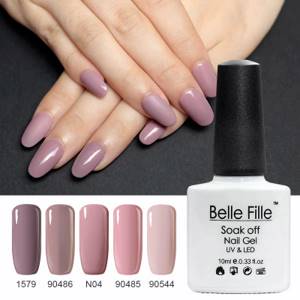
Actually, gel polish is an “average” material between a regular coating and a composition for plate extension. A special advantage of modern coating is the absence of a “nuclear” odor, which can be irritating to others during manipulation.
What is the difference between a manicure and gel polish?
The main difference between a manicure and gel polish is the principle of the procedure: in the first case, the master or the woman herself trims the length of the nail plate, gives it the desired shape, removes the cuticle and files the edge of the nail. Next, you can apply decorative (ordinary varnish) to its surface in several layers.
But to use gel polish, you will definitely need to first remove the top layer of the nail plate, which will ensure a strong fixation of the material.

In addition, during the manicure the master does not use an ultraviolet or LED lamp, and correction will have to be carried out at least once every 5 days.
What is the difference between shellac and nail extensions?
Shellac differs from nail extensions in the essence of the procedure:
- extension is an increase in the length of nails using a special gel or acrylic;
- shellac is a coating of a natural plate with a gel composition, after which it becomes stronger.
The second version of the manicure procedure does not imply lengthening the nail, but makes it more beautiful, well-groomed and neat. Correction is required only after the plate itself has grown to such a size that the color coating looks untidy.
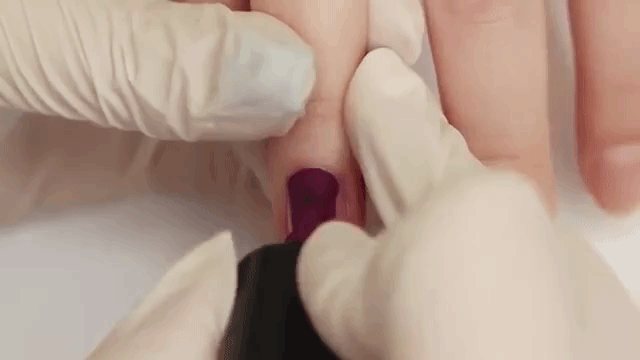
Features of nail extension:
- carried out using tips (paper, liquid, plastic);
- the tips are first glued to the client’s own nail, then filed to the required length, and given the desired shape;
- the tips remain until the acrylic/gel has completely polymerized and only then are removed;
- extension materials can cause a strong allergic reaction;
- Damage to the nail plate and even its complete separation are possible.
Nail extensions are not performed during pregnancy and during hormone therapy - the natural nail may reject the gel material or acrylic.
Watch the video about the technique of gel nail extensions:
Features of shellac:
- the length and structure of the nail plate do not change;
- the surface of the nail is pre-polished;
- Each stage of manipulation ends with drying in an ultraviolet lamp.
This coating lasts for 3 weeks, after which it is necessary to carry out correction. Perhaps it will be needed earlier - such a coating can break off, crack if the master did his work in bad faith or a woman came for manipulation during menstruation, with progressive thyroid disease.
Withdrawal procedure
To remove gel polish, you can use two removal options:
- Hardware. It involves the use of manicure cutters and attachments that quickly cut off pigment.
- Maceration. Cover the nails with remover and fix them with foil and clothespins for 10 minutes. After this, the softened excess is removed with a pusher or an orange stick.
It is difficult to remove shellac using a device, since the hard coating adheres tightly to the nail, which increases the risk of accidental damage. Because of this, specialists prefer to use a remover to carefully remove the product.
Color palette
A large number of shades and possible designs is one of the most important criteria for girls, because everyone wants their manicure or pedicure to look unique and unusual.

Shellac is just a type of gel coating, which is why it has a much smaller range of shades and designs than gel polish. In addition, the second option has many fillers and unusual effects that transform the monochromatic layer of pigment:
- Sequins;
- Chameleon;
- "Cat's Eye";
- Matte or glossy top;
- Volumetric coatings;
- Gradients;
- Magnetic compounds, etc.
Because of this, you need to be careful when applying gel polishes, since a combination of different designs and decor options can make the work sloppy and unkempt.
Gel polish or shellac - which is better, which lasts longer, how often should it be adjusted?
It is impossible to say for sure which is better – gel polish or shellac, because you need to evaluate their advantages/disadvantages, which are presented in the table for clarity.
| Benefits of gel polish | Disadvantages of gel polish |
| Manicure is done quickly - maximum 3 hours | Before application, the nail plate is seriously damaged due to its polishing |
| Thin nail plates are reliably protected from the harmful effects of external factors | It is difficult to perform the procedure at home; you will need a lot of equipment |
| Color shades are presented in a large assortment | The composition often causes an allergic reaction |
| Drying of the coating is fast and carried out in a special lamp | During the application of gel polish, an unpleasant odor of the coating is clearly felt |
| Relatively low cost of manipulation | You cannot constantly wear a manicure with gel polish, the plate will be hopelessly damaged |
| Correction can be carried out without removing the coating | It is impossible to remove the coating with ordinary means. |
| Bottles of material are sold in large volumes | The safety of using ultraviolet radiation during coating drying is questionable |
| Benefits of shellac | Disadvantages of shellac |
| Applies easily and evenly due to its homogeneous structure | High cost of material and procedure |
| The integrity of the surface of the nail plate is not compromised | It is possible for the nail to dry out if the manipulation is performed frequently. |
| The composition of the coating is hypoallergenic | Beauty preservation period – less than 2 weeks |
| The material has no odor | The coating often cracks and becomes cloudy |
| The choice of colors is quite wide | Correction cannot be performed; you will need to completely remove the old layer and apply a new one |
| Does not require the use of primer or topcoat | Vials of material are sold in minimum quantities |
| Shellac is easily removed with a special tool | Very often there are counterfeits of shellac on sale. |
Experts recommend that a woman independently decide on the choice of coating, because both materials have disadvantages and advantages.
Features of coatings using modern materials
The technology for applying modern coatings is simple, but has its own strictly defined sequence.
1. After performing antiseptic and antibacterial treatment, giving the nail plate a beautiful shape, sharpening its edge, a base coat is applied with a thin layer. It is fixed with ultraviolet light from a special lamp for 8–10 minutes. This procedure does not require mechanical treatment that injures the nail, which is provided for by the technology for nail extensions with gel or acrylic compounds.
2. Applying shellac directly to the prepared nail surface is done with familiar and traditional brushes from a bottle, and not with special spatulas from jars. The coating is leveled independently, formed with a special pencil, then fixed for 2-3 minutes using an ultraviolet light lamp. During the procedure, regardless of whether gel polish or shellac is used, there are no persistent unpleasant odors that instantly fill the room when working with traditional nail polishes.
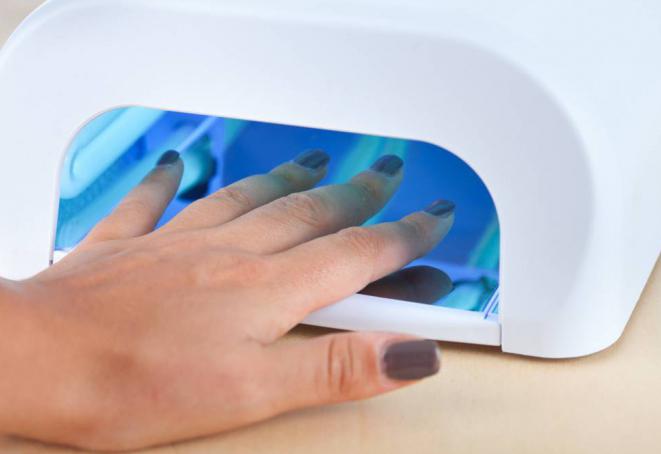
3. The final part of the procedure for covering nails with modern means is the application of a third, fixing layer using ultraviolet light.
Thus, the time required to complete the entire process takes no more than 30–40 minutes. These time costs to bring your nails to a beautiful, attractive, healthy and natural state are significantly less than those required to perform a complex acrylic extension procedure.
What is more harmful - gel or shellac?
Experts are still arguing which is more harmful - gel or shellac, and based on reviews from women and doctors, we can conclude that gel polish has the most negative effect on the nail plate. And this happens because of the composition of the coating, because it contains toxic compounds - toxins automatically enter the body, accumulate and disrupt the functioning of organs and systems.
In addition, shellac is applied in a thinner layer, wears less time and makes the plate heavier, which eliminates its thinning and increased fragility.
What to choose
Both products are good to a certain extent, so the choice depends entirely on the girl. In this case, individual characteristics (sensitivity of the body, condition of nails, etc.) should be taken into account. To understand whether gel or shellac is better, you should familiarize yourself with the pros and cons of each product.
How to do a manicure with gel polish
Review of advantages and disadvantages
| Means | pros | Minuses |
| Gel polish | • does not contain acetone; • strengthens and protects brittle nails; • has a rich color range; • it is possible to play with textures; • coating correction is allowed | • contains a large number of chemicals; • not suitable for thin nails; • if the varnish is cheap, bald spots are possible during application; • filing of the plate before use and the top layer when removing is required; • before applying nail polish you will need a primer, which can be harmful if used frequently |
| Shellac | • natural, safe composition; • hypoallergenic; • high coating strength; • resistance to external factors; • good adhesion; • purity of color shades; • glossiness of thin coating; • ease of application and removal | • due to the presence of acetone, it dries out the plate; • not subject to correction; • requires an expensive remover |
Another important feature that distinguishes the products is the influence of temperatures. When the indicators change, the gel polish coating becomes riddled with microcracks, which can cause it to flake and chip. There are no such flaws with shellac.
If we take into account the information from the table above, then the innovative composition has more advantages and almost no disadvantages. But many girls choose gel polish because of its budget. Although there is a small nuance here: the cheaper the products, the worse the quality.
Note! If you want to save your family budget, it is recommended to choose a well-known brand. This will at least ensure that the product meets the required requirements.
Name of shellacs
If you use shellacs for decorative coating, then you need to know the names of the most famous, popular and safest materials:
| Name | Description | Photo |
| Shellac CND | Ideal consistency, comfortable brush, manicure will be characterized by maximum stability. Studies have been conducted that have confirmed the safety of the coating for the health of the nail plates. Shellac from this manufacturer has a very dense structure and is easily removed from nails. Ideal coverage is obtained after applying only 2 layers. |
|
| Kodi | A hard brush, a short “wearing” period of the decorative coating, an assortment of almost 400 color shades, there is even a “cat’s eye”. The texture of shellac is not dense, but it does not flow when applied to the plate. Some colors, even with numerous layers, do not cover the nail - for example, yellow and orange. |
|
| Bluesky | Inexpensive material, it features a high-quality, fluffy brush, which simplifies the process of applying shellac to the nail. The consistency of the material is liquid, but its pigment sometimes penetrates the nail and colors it. The shelf life of the manicure coating does not exceed 10 days, but the color palette includes about 600 shades. |
|
If a woman has a choice, then preference should be given to more expensive brands of shellac, because only this will ensure safety for health and a longer period of wearing the decorative coating.
How to extend the wearing period
To extend the wearing of shellac or gel polish, you should follow the following recommendations from the experts:
- do not allow aggressive substances to get on your nails;
- prevent exposure of plates with decorative coating to high temperatures;
- do not wash dishes or clean without gloves;
- do not scratch the coating;
- Do not try to remove it with nail scissors, knives, or flat screwdrivers.
Watch the video on how to extend the wearing time of gel polish:
Some tips for craftsmen
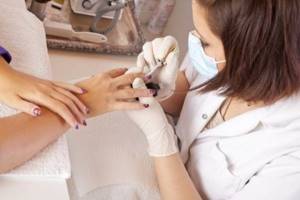
Masters are several times more susceptible to side effects from using toxic products than their clients. To make work safe, and also not to encounter the development of diseases, it is recommended to follow several tips:
- Use only high-quality products - this will affect the quality of your manicure and protect you from allergies, headaches and other side effects;
- Wear gloves. Yes, it will be uncomfortable at first, but by protecting your hands, you will save your skin from contact with harmful substances of the composition;
- Use a mask to reduce the amount of fumes and dust you inhale.
Personal protective equipment for a manicurist - all types of harmful effects in the salon and how to protect yourself
Risks of wearing
Despite the beauty of gel polish and shellac coating, you need to remember the possible risks of wearing:
- stripes, tubercles, and roughness form on the surface of the nails;
- the color of the plate may acquire a yellowish or gray tint;
- nails (your own) completely lose their shine;
- delaminations appear on the protruding section of the plate;
- the cuticle and periungual area of the skin become covered with hangnails and roughness.

Nails after removing gel polish
At what age can you
The optimal age at which you can start applying durable decorative coatings is 16 years.
No matter how good gel polish and shellac are, no matter how expensive and high quality they are, they can have a detrimental effect on an unformed nail plate. Medicine officially states that up to the age of 14, nails still remain soft and are at the stage of formation/growth/strengthening. Gel polishes and shellac not only damage the nail, but also directly affect the functioning of the hormonal system.
We recommend reading the article about what you need to know when choosing a lamp for gel polish. From it you will learn why you need a lamp for gel polish, how it works, and how to choose a lamp for drying gel polish. And here is more information about how to remove shellac at home.
Gel polish and shellac are considered an excellent choice for long-term wearing of manicure and preserving the decorative coating of nails. When choosing a specific material, it is worth taking into account their quality characteristics, composition and impact on a woman’s health. In any case, it is worth contacting specialists and this should be done no earlier than 16 years of age.
Security categories Free
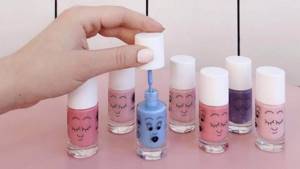
Manufacturers of nail polishes indicate on the label the safety category “Free” plus a number from 3 to 12. Such polishes are “free” from a number of toxic chemicals that can cause serious illnesses.
3-Free
3-Free varnishes do not contain formaldehyde, toluene or plasticizers.
There are several varnishes of the 3-free category on the Russian market:
- Divage;
- Orly;
- Patrisa Nail;
- Rimmel;
- Maybelline.
5-Free

In addition to formaldehyde, toluene and plasticizers, 5-Free products also do not use formaldehyde resin or camphor.
Brands designated 5-Free:
- Aurelia;
- Chanel;
- Zoya;
- Inglot.
7-Free
7-Free varnishes are free of xylene, formaldehyde and its resins, camphor, triphenyl phosphate, toluene and dibutyl phtholate.
Lucky 7-free:
- ANNY;
- CND Shellac;
- Jessica;
- LVX.
8-Free
8-Free does not contain the 7 components listed above and does not contain parabens.
There are not many products on the Russian market without 8 hazardous substances:
- By Terry;
- Smith & Cult;
- Tenoverten.
10-Free
10-Free polishes are considered vegan. They do not contain all of the above harmful substances, as well as components of animal origin - guanine, keratin and carmine, and are not tested on animals.
No toxic substances are used in production. Vegan polishes:
- ZAO;
- Butter LONDON;
- Color Club.
You can also find 11, 12 and even 13-free on sale, but this is more of a marketing ploy. Manufacturers do exclude some common ingredients, such as gluten, which is inherently safe. Gluten can cause negative reactions only in a narrow part of the population - those who are lactose intolerant.
